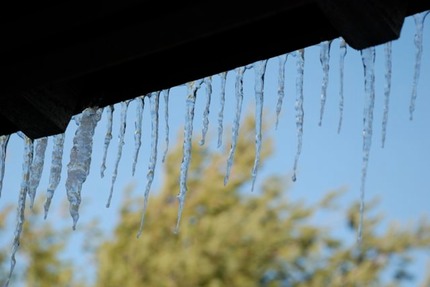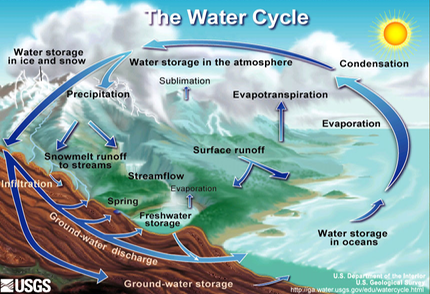Background Information: The first step to understanding the water cycle in understanding the states of matter. Water is an ideal substance to study because it exhibits three of the states of matter (solid, liquid, gas) at relatively normal temperatures.
Solid Water (ice, hail, snow):
Gather:
- Plastic tubs of different sizes, food molds, ice cube trays, clean milk cartons, etc.
- Access to freezer
- Water
- Food coloring (optional)
- Spray bottle (optional)
- Springs of herbs, flower petals (optional)
Put some water in different-shaped containers and freeze it. Allow the children to help pick containers and fill them. For added enjoyment, add a few drops of food coloring to the water. Or you can add bits of edible flowers such as roses, or leaves of herbs as decorations. Explain that the liquid water is going to become solid.
On a warm day, take the ice outside and use it to build ice sculptures. Remove the ice from the containers by briefly immersing in water if it won’t just slip out. If you don’t have time to make special shapes, simple ice cubes can work great for this, too.
Have the children pile the ice to make buildings, animals or abstract forms. You can lightly mist the finished products with water containing food coloring. Then watch the sculptures melt. Predict how long it will take. Explain that the solid water is becoming liquid water by melting.
Older children can design inventions to protect the ice from melting, and then build and test their invention by seeing how long it takes for the ice to melt inside the device versus unprotected.

Liquid Water:
Learning how to make a water siphon is a fun and useful way to learn about some of the properties of liquid water.
Gather:
- Small amount of tubing, such as clear plastic aquarium tubing – about 18 to 24 inches long
- Water
- Two bowls or other containers large enough to hold tubing submerged, or even a large glass and a sink
- Food coloring (optional)
Fill one of the containers with water. Add a few drops of food coloring (optional). Submerge the tubing under the water and jiggle to remove air bubbles until the tube is filled with water. Place your thumb tightly over one end of the tube and move it to an empty container, ideally slightly lower than the first. Release your thumb and the water should start moving from the filled bowl to the empty one via siphon action. It may take some practice if you have never done it before.
You can also put two straws together to use instead of tubing.
For older children, time how long it takes to fill a container of known size and calculate rate of flow. Figure out how long it would take to empty a ten gallon fish tank with your siphon. How about an average swimming pool?
Water as a Gas :
To study water in the gas form, you will need water, paint brushes and a sidewalk or driveway on a hot day. If you must stay indoors, a chalkboard will work too. Simply paint the water onto a flat surface and then time how long it takes to evaporate. Explain that the liquid water is turning into a gas as it disappears and is rising up into the air. That is called evaporation.
To show the gas water turning back into liquid, set out a glass full of ice water on a warm day. The gas should condense into liquid around the outside of the glass after a few minutes, creating droplets. This is called condensation.

The USGS has child-friendly information about the water cycle, including a printable poster.
If you would like to make a terrarium as a model of a water cycle, see our previous post.
The bottom line is that you could spend a lifetime studying water.

